Michael Watson Relies on Horsepower to Shoot ‘Lovecraft Country’
Welcome to World Builders, our ongoing series of conversations with the most productive and thoughtful behind-the-scenes craftspeople in the industry. In this entry, we chat with cinematographer Michael Watson about balancing the unreal with the very real horrors of Lovecraft Country.
You don’t have time to get comfortable. Lovecraft Country does not care if you’re ready for its world or not. The reality is that you’re already living inside it, and its science fiction, fantasy, and horror elements are merely metaphorical mirrors used to highlight the terrors surrounding us twenty-four-seven, three-sixty-five.
When the creatures of the night reveal themselves, it’s a relief from the unapologetic, ordinary, and violent racism confronting our heroes. You can stake a vampire, but what do you do with a Klansman? Maybe the same thing? Definitely the same thing.
In Lovecraft Country, flesh-hungry Shoggoths stand in concert with the photographic activism of Gordon Parks. James Baldwin blares against the hatred buried within the fiction of H.P. Lovecraft and Edgar Rice Burroughs. Creating a canvas where such juxtaposition can thrive is a challenge, but it’s one that few cinematographers ever get the chance to attempt.
When Michael Watson was hired to shoot the series in collaboration with Robert McLachlan, he was given the pilot to study. What Watson saw struck a serious creative nerve. He immediately knew the revelatory potential of Lovecraft Country.
“The show is so unique,” says Watson. “It’s almost three different genres wrapped into one and dropped into 1950s Jim Crow America. When I started reading the scripts, I knew right away that this show was going to be huge. Then, working with the level of artisans where everybody was basically swinging for the fences? We were hoping for a grand slam.”
Selling a wide variety of monsters is an issue of acceptance. The camera can never wink or approach the absurdity in a knowing way. All the beasts should be as tangible as the baseball bat Jackie Robinson uses to bash them back.
“The feel here is kind of like pulp sci-fi set in period horror,” he says. “Rob and I had a lot of discussions with the visual effects team. We wanted to be in a place where none of the effects, whether it was the creatures or the magic, seemed campy. We wanted to stay as far away from that as possible. In doing so, it lent a sense of reality to the whole thing.”

Working his way through the scripts, Watson admired their clarity of vision. Sure, the situations Atticus Freeman (Jonathan Majors) and Leti Lewis (Jurnee Smollett) encounter are fantastical, but they are carefully crafted and steeped in respect for the genre. Watson wanted to return the favor with the visual language.
“Rob and I took a really strong look at the pilot,” says Watson. “We wanted to bring a much more cinematic feel than the pilot delivered. We felt that was the best approach, and that’s how we ended up deciding on the lighting style and a camera package that we felt could best achieve that.”
The Lovecraft Country pilot was captured on an Arri Alexa. Watson and McLachlan decided Sony’s VENICE, which allowed them to shoot 60fps at 6K, was a better fit. In combination with the ZEISS Supreme Primes, the cinematographers could achieve an anamorphic look with all the advantages of spherical lenses.
“The combination between the Sony VENICE and the speed of the Supreme Primes gave an incredibly shallow depth of field on a full-frame sensor,” he continues. “It just really gave the show an incredibly cinematic look.”
The VENICE supplied Lovecraft Country more bang for its buck. Everyone involved in the series reached for epic heights, wanting to match the power of the screenplays. The culture is ravenous for social science fiction. They want to see every genre tackle the dread and fears steeped in today.
“Another thing that Rob and I also discussed was trying to utilize our horsepower,” says Watson. “By that, I mean, HBO did such an incredible job of handpicking the collaborators on the show. We ended up with such a high level of artisanship by the production design on some of the sets that were built. We had these incredibly large, incredibly photographic set pieces, and we agreed that we would always go as big as we could to capture as much of what was given.”

Lovecraft Country‘s fantasy is rooted in our very real history. To accomplish an anchor to the past, the producers and the cinematographers agreed to set their frames in those established by iconic photographers. In addition to Gordon Parks, throughout the series, you will see homages to the works of Harold Feinstein, Fan Ho, and Fred Herzog.
“I did a huge amount of research on photographers of that era,” he says. “That was the driving force for myself, and basically how I approached the framing of my episodes in particular. There was something about how those photographers framed a little bit wider but also closer. It just gives that feeling where you’re more immersed in the moment.”
Before Watson shot frame one, he built a collection of images. There was a flurry of notes, a scramble of ideas. Piece by piece, they come together. His concept for Lovecraft Country formed in his mind, and he trapped it inside a lookbook.
“Rob probably has a very different process than what I use,” says Watson. “I tend to put together my own personal lookbook, right? It’s based on the scripts. I go into each individual episode already having an idea of where I want to be photographically. I share that insight with my gaffer and my key grip, and that helps us stay true to the initial imagery that inspired this look. Nineteen-fifty-four Chicago, the feel, the texture.”
Assembling the lookbook is an activity born from inspiration and technicalities. Watson scours the scripts for problems requiring solutions. The solutions define the photographic philosophy of the series.
“The thing that jumps out to me the most is the time of day,” he says. “If there’s a lighting gap, or if there’s a reference to a certain quality of light. Is it an early morning light, streaming through windows, or is it a scene where it’s night in a city in 1920-something Tulsa? So for that, would there be gas lamps? Would there have been electric? From there, I go through my library of images that I’ve already generated based on that period, and see what resonates with that kind of quality of light and that feel and that tone within the script.”
Michael Watson and Robert McLachlan approached Lovecraft Country‘s lighting naturalistically. Everything goes back to the respect given the characters and their situations. The series is an authentic experience, from the emotions to the costumes to the camera work. Atticus faces extreme circumstances, but they never feel false. Watson found truth in every moment.
Lovecraft Country is now streaming on HBO.





